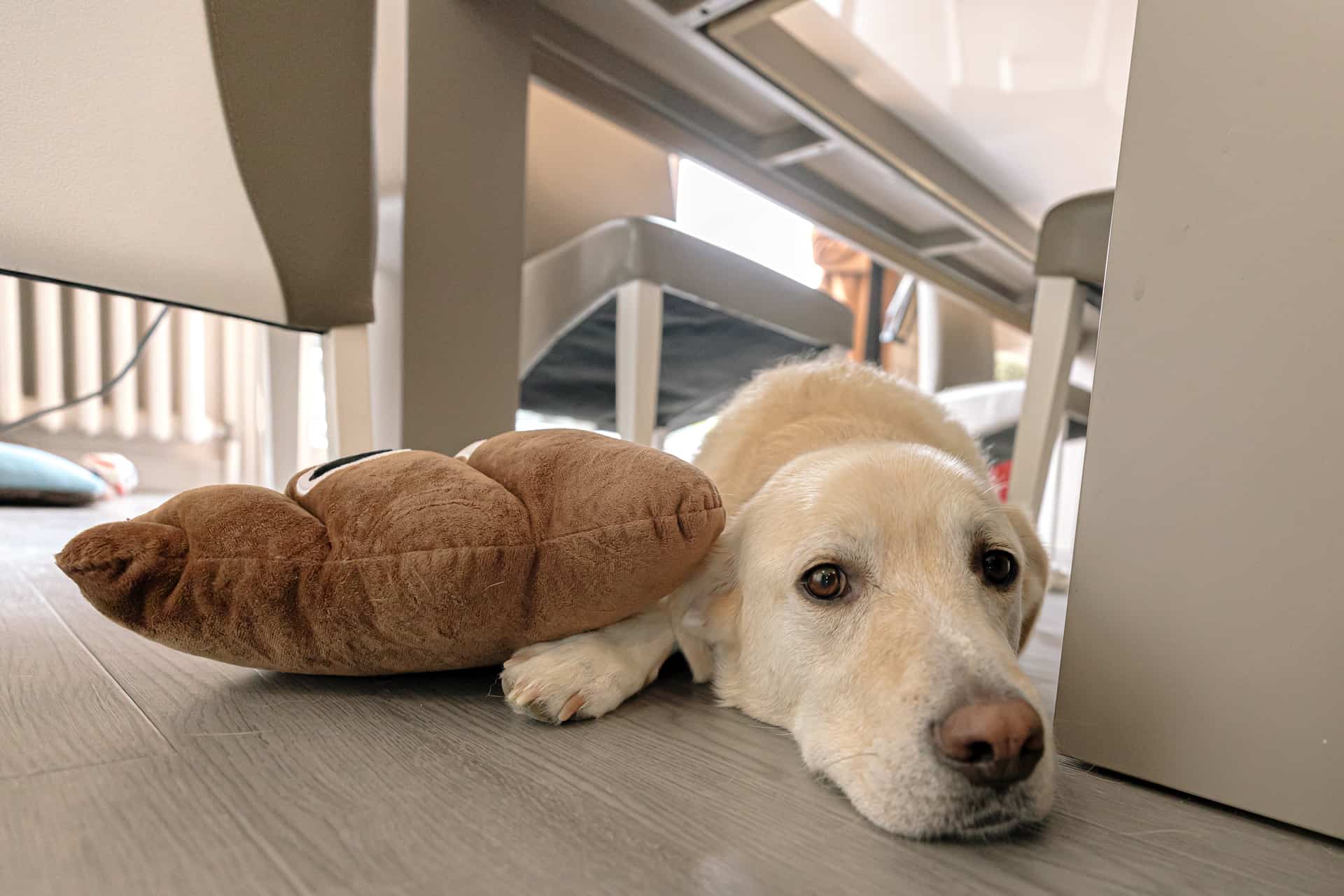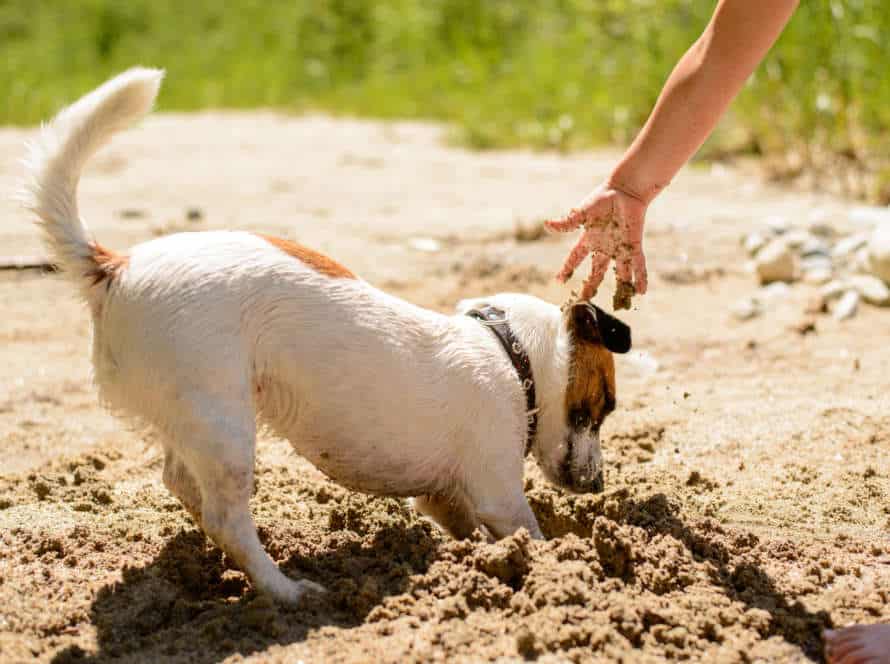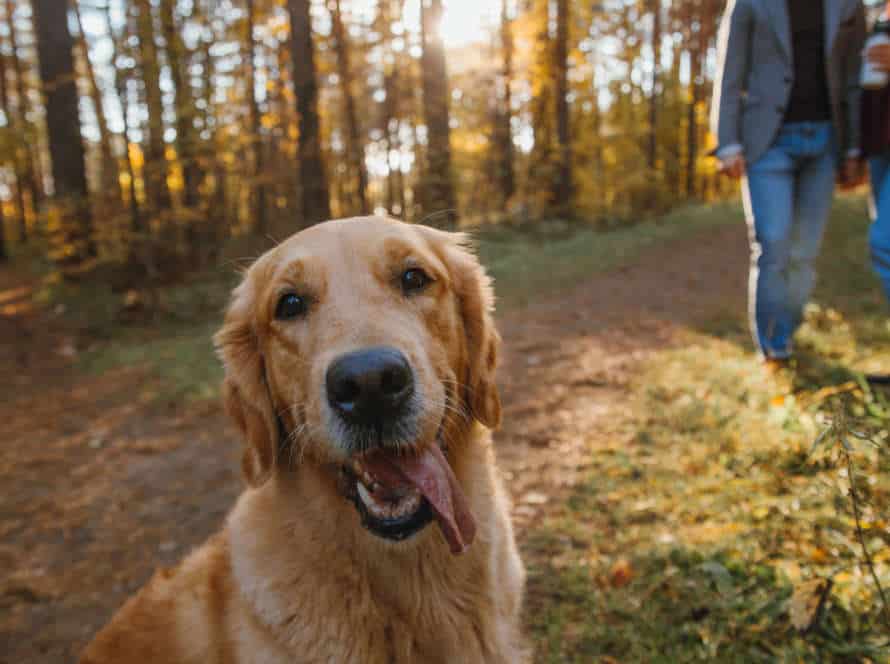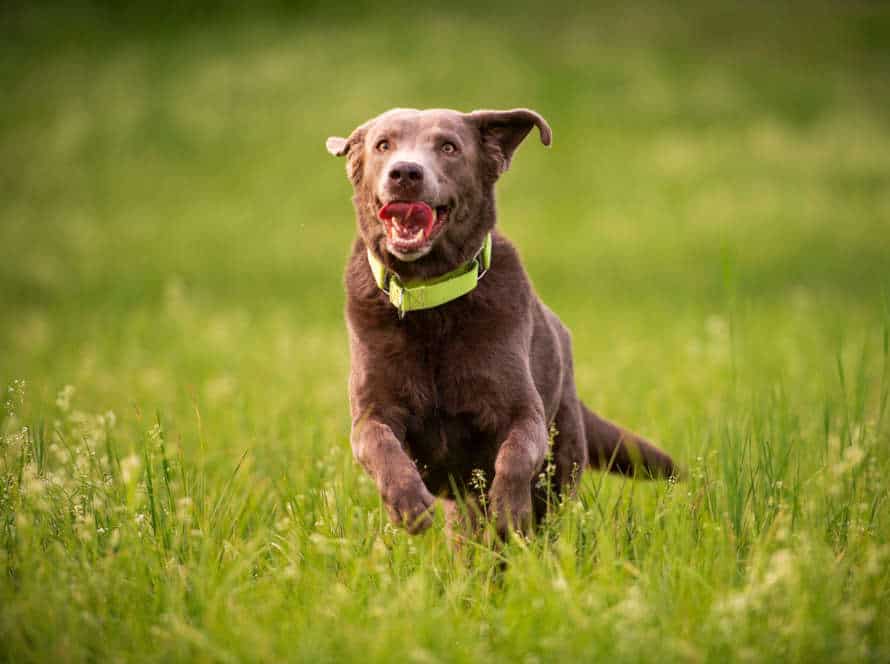Assessing the Severity of Your Dog’s Separation Anxiety
Assessing the severity of your pup’s separation anxiety is important. Here’s how to do it:
- Examine your dog’s behaviour. If they become anxious when you leave, or if they tremble or whine, this may imply a severe case of separation anxiety.
- Monitor your dog while you’re out. If they are destructive, urinating/defecating, or excessively barking/howling, this suggests moderate to severe anxiety.
- Consult a vet. They can assess your dog’s behaviour and suggest the best treatment plan.
It’s essential to intervene early. This will help manage separation anxiety and ensure your dog’s emotional and physical well-being.
Recognizing Symptoms of Separation Anxiety in Dogs
Separation anxiety in pets can be tricky to spot. But, understanding the signs can help you to identify it fast and give your pet the help they need. Common signs of separation anxiety in doggos are bawling, woofing, restlessness and destructive behaviour when the owner is away. In this article, we will look at more symptoms and how to find out how bad your pup’s separation anxiety is.
Howling, Barking, or Whining
Separation anxiety is a common problem for pooches. It can cause barking, howling, or whining when left alone. Know the symptoms:
- Often vocalizing.
- Damaging things.
- Making messes.
- Trying to flee.
For how bad the anxiety is, consider the time and intensity of the signs, plus how distressed your pup appears. Talk to a vet or behavior specialist to make a plan.
Pacing, Digging, or Chewing
Separation anxiety is a common problem in dogs. It can show itself in different ways, like pacing, digging, or chewing. Here’s how to know the signs and how serious it is:
- Pacing- If your pup goes back and forth, it can mean they feel anxious. Look out for other signs like panting or whimpering.
- Digging- If they’re digging or scratching too much, especially at windows or doors, it could be caused by separation anxiety. Listen out for howling or barking when they’re alone.
- Chewing- Chewing on stuff they shouldn’t? It may be because they’re bored or anxious. Drooling or panting when they’re left alone can mean it’s really serious.
If you think your dog has separation anxiety, get help from a vet or dog trainer. Each case is different, so you need the right solution for your pup.
Urinating or Defecating Indoors
Urinating or pooping inside can be a sign of separation anxiety in dogs. This can be really tough for both you and your pup. So, it’s important to identify the symptoms of this behavior problem and figure out how severe your pup’s anxiety is.
Symptoms of Separation Anxiety:
- Excessive barking/howling when left alone
- Destructive behavior near exits/entrances (doors/windows)
- Pacing or restlessness early on in your departure
- Urinating or defecating indoors
Severity of Separation Anxiety:
To find out how bad it is, observe your pup’s behavior while you’re away. Note down damage done, sound levels of barking/howling. Also, look out for physical signs like drooling/vomiting. A vet can do an assessment to find the right treatment plan.
Pro Tip: Consult an experienced vet or animal behaviorist to get help for your pup’s anxiety.
Determining If Your Dog Has Separation Anxiety
Is your dog displaying signs of separation anxiety? It’s essential to know what you’re looking for and how serious the situation is. Separation anxiety happens when a pooch is left alone and is extremely upset. Typical symptoms are too much barking, whining, chewing, and digging. In this article, we’ll explore different ways to identify if your canine has this condition and what to do to make them feel better.
Record and Analyze Your Dog’s Behavior
Analyzing your dog’s behavior can help you identify if they have separation anxiety. To do this, set up a camera before leaving them alone. Look out for signs like barking, whining, pacing or destructive behavior. Take notes on the duration of each episode and share them with a vet or animal behaviorist. Prompt action is important to stop the issue from getting worse.
Pro Tip: Desensitization, behavior modification and anti-anxiety meds are effective treatments.
Conduct a Safe Separation Test
Are you concerned your dog has separation anxiety? Test it out with a Safe Separation Test! Here’s what to do:
- Choose when you’ll be away for a few moments, like running an errand.
- Prepare a cozy, safe space for your pup, like a crate or section of your home.
- Give them toys, bedding and a treat or two.
- Leave the room and wait outside for 5-10 minutes.
- Return and watch your dog’s behavior. Signs of distress could be barking, destructiveness, or trying to escape.
- If they seem anxious, try a shorter time away, add exercise, or get help from a vet.
Separation anxiety is treatable. With patience and consistency, your pup will feel comfy when you’re gone.
Tip: Take it slow and up the separation time gradually, to help them adjust.
Consult a Veterinarian or a Professional Trainer
Suspect your dog has separation anxiety? It’s essential to consult a veterinarian. They can check for medical issues, prescribe medication, and refer you to a trainer.
A professional trainer can assess the severity of the condition. They can provide customized training plans, teach techniques such as desensitization and counterconditioning, and show how to do gradual separation.
It’s crucial to seek professional help. Your dog needs the best care and treatment for their separation anxiety.
Assessing the Severity of Your Dog’s Separation Anxiety
Recognize the signs of your dog’s separation anxiety! It can vary from mild to severe. Spotting it early on is key to avoiding a bigger problem. Know the difference between levels of severity.
Here are some signs, symptoms, and behaviors that signify the severity of your pup’s anxiety:
Use a Dog Separation Anxiety Severity Scale
Do you want to help your pup with their separation anxiety? Using a dog separation anxiety severity scale is a great way to assess the level of seriousness and take the right measures. Here are the 7 indicators that are usually included:
- Panting, drooling, salivating.
- Excessive barking, howling, whining.
- Scratching, digging, chewing destructively.
- Pacing or restlessness.
- Loss of appetite or GI problems.
- Urinating or pooping inside, even if potty-trained.
- Escape attempts or destruction of items blocking them from you.
Pro tip: If any of these signs are present, address the issue quickly to prevent it from getting worse. Get help from a vet or certified trainer to make an effective plan.
Analyze the Duration and Intensity of Symptoms
To assess the severity of your pup’s separation anxiety, analyze the duration and intensity of the symptoms. Common signs include: destructive behavior, loud barking, and soiling. Keep a log of your dog’s behavior while you’re away. Note the time you left and returned, and any changes in their behavior.
If they only show mild symptoms for a short duration (e.g., a few minutes of barking), then the anxiety is probably mild. But if they display severe symptoms (e.g., hours of barking, destructive behavior, or self-injury), it’s likely they have a serious case of separation anxiety that needs immediate attention.
To effectively manage the condition, seek professional guidance as soon as possible.
Take Note of the Frequency and Consistency of Behavior
To work out the seriousness of your pup’s separation anxiety, note the regularity and consistency of their actions.
Separation anxiety in doggos can be shown in lots of different ways. Regular symptoms include barking, whining, howling, destructive behavior, house-soiling accidents, and trying to escape.
Here’s what to look out for:
- Frequency: How often does your pup do these things? Once a week, once a day, or each time you leave the house? The more regular, the more serious.
- Consistency: Does your pup always show the same signs when you leave, or do they change? Consistent behavior means it’s a more serious case of separation anxiety.
Once you’ve checked the frequency and consistency of your pup’s behavior, you can find out the seriousness of their separation anxiety and think about the correct measures to help them.
Understanding the Causes of Separation Anxiety in Dogs
Separation anxiety in dogs can be tricky to fix. It’s essential to grasp why your pup may have the disorder. This article will discuss the possible reasons behind dog separation anxiety, so you can determine how severe it is and create a plan to tackle it.
Lack of Proper Socialization or Training
Poor socialization or training can lead to separation anxiety in dogs. Dogs with no prior exposure to different people, places and scenarios may become scared and stressed when left alone.
Here are a few tips to address this type of anxiety:
- Begin with fundamental obedience training to establish an understanding of trust and respect between you and your pup.
- Slowly introduce your pup to new people, places, and situations, using positive reinforcement to help them gain confidence and reduce stress.
- Use desensitization and counter-conditioning to help your pup become comfortable with being alone for shorter periods.
- If your dog’s anxiety is severe or prolonged, seek the help of a professional trainer or behaviorist.
Traumatic Experiences
Separation anxiety in dogs can be caused by traumatic experiences such as abandonment, loss of an owner, or routine changes. To help your dog adapt, it’s important to understand the root causes.
A few common causes:
- A sudden change in routine, like pandemic working from home or post-holiday season.
- A history of neglect, abuse, or abandonment.
- Loss of an owner or companion animal.
- Lack of exercise or socialization.
- Genetics, temperament, and overall health.
Assessing the severity of your dog’s separation anxiety is essential. Signs to look out for include barking/panting, destructive behavior, and inappropriate defecation/urination. In severe cases, they may refuse to eat/drink, self-harm, or become aggressive.
Professional help from a vet or dog behaviorist is recommended to effectively treat your dog’s separation anxiety.
Medical Conditions or Genetic Predisposition
Separation anxiety in dogs can be caused by medical conditions or genetics. Hypothyroidism, urinary tract infections, and gastrointestinal issues can lead to this disorder. Certain breeds, like Australian Shepherds and German Shepherds, are more likely to get anxiety.
Assessing the severity of separation anxiety is important. Mild cases need training and changes in routine. Severe cases require medication, under a vet or animal behaviorist’s guidance.
Mild signs: barking/whining when you leave, destructive behavior, restlessness.
Severe signs: self-harm, aggression, excessive drooling.
If your dog has severe anxiety, seek professional help right away.
Managing and Treating Separation Anxiety in Dogs
Do you have a dog with separation anxiety? It can be tough for the pet and its owner. Fortunately, there are ways to help. This article covers how to find out the seriousness of your pup’s anxiety. Plus, we’ll look at some techniques and methods that work for managing it.
Gradual Desensitization and Counterconditioning Techniques
Assess your dog’s separation anxiety. It’s essential to start. Manage and treat with gradual desensitization and counterconditioning.
Signs:
- Panting, drooling?
- Barking, howling, whining?
- Destroying furniture?
- Scratching doors or windows?
- Escaping the house?
Create a low-stress environment. Introduce your pup to alone time. Gradual desensitization: introduce increasing amounts of alone time. Counterconditioning: change emotional response by pairing alone time with positive experiences. Get help from a certified dog behaviorist. Make a plan that fits your pup’s needs.
Medications and Supplements
Medications and supplements can be useful for dealing with separation anxiety in dogs. But, it’s important to find out how serious your dog’s condition is before starting any treatment.
For mild cases, behaviour modification techniques can help. For example, letting your dog spend time alone gradually or giving them toys and puzzles.
For more severe cases, medication may be needed. This could include anti-anxiety drugs, antidepressants, or sedatives. Always get the medication from a vet.
Supplements like melatonin and chamomile may calm down anxious dogs. But, you must speak to your vet before giving your dog any supplements to make sure they’re safe and will work.
Professional Behavioral Modification Training
Behavioral Modification Training for dogs is great for treating separation anxiety. But, first, assess the severity.
These 3 signs suggest separation anxiety:
- Destructive behavior – furniture destruction, chewing walls/skin, soiling the house when alone.
- Excessive barking, whining, howling when left alone.
- Escape attempts – trying to leave the house or crate while you’re away.
Identifying signs is key in understanding the level of anxiety and making a plan with your veterinarian and dog trainer.
Frequently Asked Questions
1. What is separation anxiety in dogs?
Separation anxiety in dogs is a behavioral disorder that occurs when they become distressed and anxious when separated from their owner or household members.
2. What are the signs of separation anxiety in dogs?
Signs of separation anxiety in dogs include excessive barking or howling, destructiveness, attempts to escape, pacing or restlessness, and inappropriate elimination.
3. How severe can separation anxiety in dogs be?
Separation anxiety in dogs can range from mild to severe. Mild cases may involve some whimpering or pacing, while severe cases may involve destructive behavior and self-injury.
4. How can I assess the severity of my dog’s separation anxiety?
You can assess the severity of your dog’s separation anxiety by observing their behavior when you are away. Record their behavior such as: time barking or howling, objects destroyed, or the extent of destructiveness. A dog trainer or veterinarian can also help evaluate their anxiety levels.
5. How can I help my dog cope with separation anxiety?
You can help your dog cope with separation anxiety by gradually increasing the time they spend away from you, providing plenty of exercise and mental stimulation, using aromatherapy or calming music, and seeking help from a professional dog trainer or veterinarian.
6. Can medication help with separation anxiety in dogs?
Medication can help with separation anxiety in dogs in severe cases. However, it should be used in conjunction with behavioral training and under the guidance of a veterinarian.







